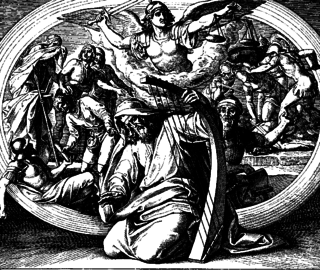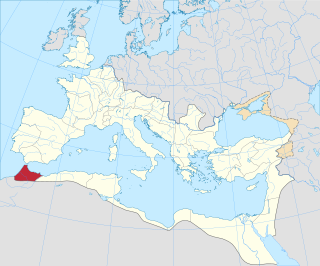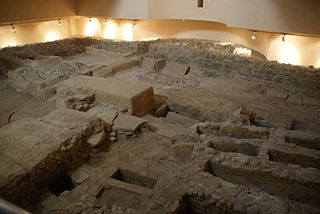See also
| This disambiguation page lists articles associated with the title Septem. If an internal link led you here, you may wish to change the link to point directly to the intended article. |
Septem may refer to:
| This disambiguation page lists articles associated with the title Septem. If an internal link led you here, you may wish to change the link to point directly to the intended article. |

Ceuta is a Spanish autonomous city on the north coast of Africa.

The seven hills of Rome east of the river Tiber form the geographical heart of Rome, within the walls of the city.
Zepto is a unit prefix in the metric system denoting a factor of 10−21 or 0.000000000000000000001.

De humani corporis fabrica libri septem is a set of books on human anatomy written by Andreas Vesalius (1514–1564) and published in 1543. It was a major advance in the history of anatomy over the long-dominant work of Galen, and presented itself as such.

Guanabara Bay is an oceanic bay located in Southeast Brazil in the state of Rio de Janeiro. On its western shore lies the cities of Rio de Janeiro and Duque de Caxias, and on its eastern shore the cities of Niterói and São Gonçalo. Four other municipalities surround the bay's shores. Guanabara Bay is the second largest bay in area in Brazil, at 412 square kilometres (159 sq mi), with a perimeter of 143 kilometres (89 mi).

The Septimontium was a pre-urban festival celebrated in ancient Rome by montani, residents of the seven (sept-) communities associated with the hills or peaks of Rome (montes): Oppius, Palatium, Velia, Fagutal, Cermalus, Caelius, and Cispius. The Septimontium was celebrated in September, or, according to later calendars, on 11 December. It was not a public festival in the sense of feriae populi, according to Varro, who sees it as an urban analog to the rural Paganalia.
777 is the natural number following 776 and preceding 778. The number 777 is significant in numerous religious and political contexts. For Boeing 777, click here
The Defence of the Seven Sacraments is a theological treatise published in 1521 , written by King Henry VIII of England, allegedly with the assistance of Thomas More. The extent of More's involvement with this project has been a point of contention since its publication.

The Penitential Psalms or Psalms of Confession, so named in Cassiodorus's commentary of the 6th century AD, are the Psalms 6, 31, 37, 50, 101, 129, and 142.

Mauretania Tingitana was a Roman province located in the Maghreb, coinciding roughly with the northern part of present-day Morocco. The territory stretched from the northern peninsula opposite Gibraltar, to Sala Colonia and Volubilis to the south, and as far east as the Mulucha river. Its capital city was Tingis, which is the modern Tangier. Other major cities of the province were Iulia Valentia Banasa, Septem, Rusadir, Lixus and Tamuda.

The Siebengebirge(

A tree of virtues is a diagram used in medieval Christian tradition to display the relationships between virtues, usually juxtaposed with a tree of vices where the vices are treated in a parallel fashion. Together with genealogical trees, these diagrams qualify as among the earliest explicit tree-diagrams in history, emerging in the High Middle Ages.

Abyla was the pre-roman name of Ad Septem Fratres. Ad Septem Fratres, usually shortened to Septem or Septa, was a Roman colony in the province of Mauretania Tingitana and a Byzantine outpost in the exarchate of Africa. Its ruins are located within present-day Ceuta, an autonomous Spanish city in northwest Africa.

Seven Sermons to the Dead is a collection of seven mystical or "Gnostic" texts written and privately published by C. G. Jung in 1916, under the title Seven Sermons to the Dead, written by Basilides of Alexandria, the city where East and West meet. Jung did not identify himself as the author of the publication and instead ascribed it to the early Christian Gnostic religious teacher, Basilides. Seven Sermons is a part of Jung's The Red Book and can be described as its "summary revelation". Seven Sermons is the only portion of the material contained in The Red Book manuscripts that Jung shared privately during his lifetime. The Red Book was published posthumously in October 2009. Shamdasani's introduction and notes on the text of The Red Book provide previously unavailable primary documentation on this important period of Jung's life.

The Diocese of the Seven Provinces, originally called the Diocese of Vienne after the city of Vienna, was a diocese of the later Roman Empire, under the praetorian prefecture of Gaul. It encompassed southern and western Gaul, that is, modern France south and west of the Loire, including Provence.
Musical settings of sayings of Jesus on the cross are compositions which set seven short phrases uttered by Jesus on the cross, as gathered from the four Christian Gospels narrating the Crucifixion of Jesus. Several composers have written musical settings of the traditional collection of seven sayings, sometimes called Seven Last Words and ultima septem verba, for various combinations of voice and/or instruments. Eventually these settings became a separate form of Passion music. Perhaps the most outstanding work in this genre in the Lutheran tradition is the work by Heinrich Schütz. Joseph Haydn composed string quartets titled Die sieben letzten Worte unseres Erlösers am Kreuze.
The Council of the Seven Provinces was a governing body of the Seven Provinces in the praetorian prefecture of Gaul, then part of the Western Roman Empire. Between its establishment in 418 and its demise in the 460s, it met annually in Arles between mid-August and mid-September. Its members belonged to the Gallo-Roman aristocracy, including the bishops.

The Arch of Augustus at Rimini was dedicated to the Emperor Augustus by the Roman Senate in 27 BC and is the oldest Roman arch which survives. It signaled the end of the via Flaminia, which connected the cities of Romagna to Rome, and spans the modern Corso d'Augusto, which led to the beginning of another road, the via Emilia, which ran northwest to Piacenza.

Santa Lucia in Septisolio was an ancient Roman church with a diaconia. It formerly stood at the base of the Palatine Hill, near the Septizodium of Septimius Severus, from which it took its name. The date of its destruction is not certain, although it seems to have disappeared definitively after the pontificate of Sixtus V (1585–1590).
De septem sigillis is the name of several works: